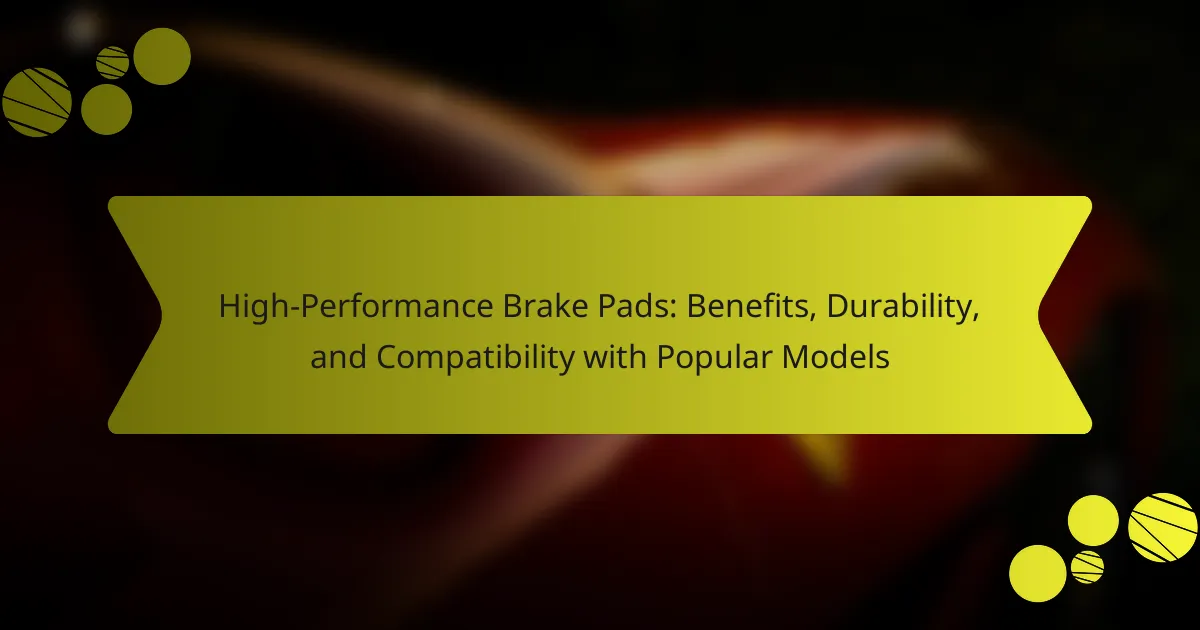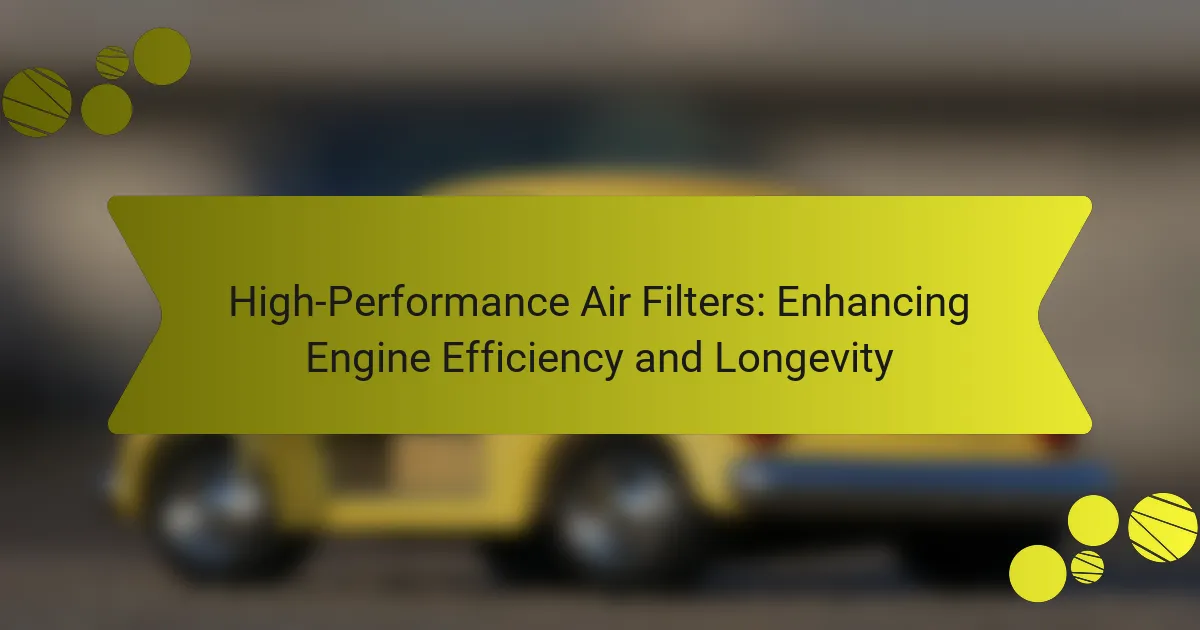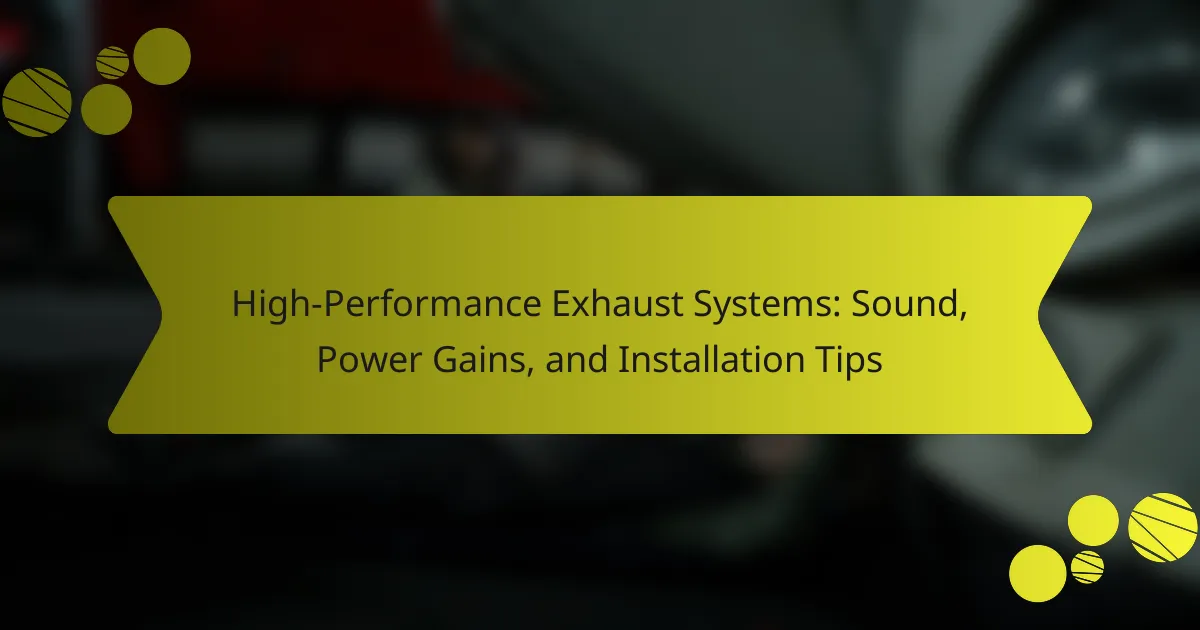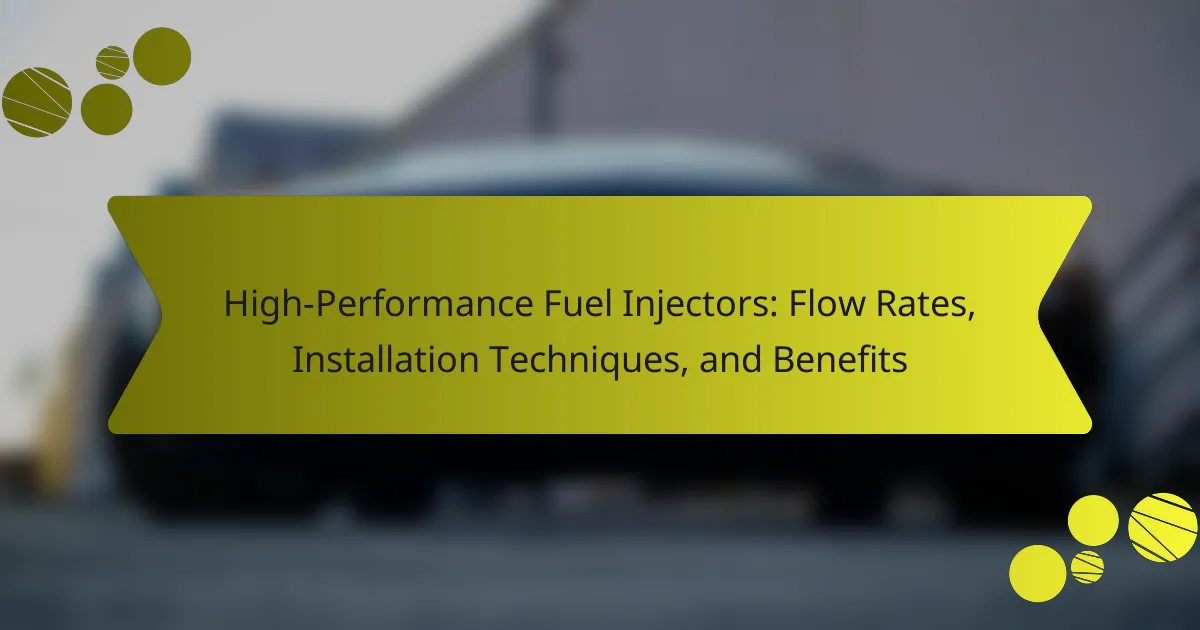High-performance brake pads significantly enhance stopping power, ensuring better vehicle control and safety. They offer superior durability, lasting up to 50% longer than standard options. Compatibility with popular models like the Ford Mustang and BMW 3 Series allows for easy upgrades. Unique materials improve heat resistance and performance under extreme conditions, making them ideal for enthusiasts.

What are the key benefits of high-performance brake pads?
High-performance brake pads offer enhanced stopping power, improved heat dissipation, and longer lifespan compared to standard pads. These benefits translate into better vehicle control and safety. Additionally, they are compatible with popular models, ensuring optimal performance across various vehicles. Their unique attribute is the ability to maintain effectiveness under extreme driving conditions, making them ideal for enthusiasts and performance vehicles.
How do high-performance brake pads enhance vehicle safety?
High-performance brake pads significantly enhance vehicle safety by providing superior stopping power and heat resistance. These pads reduce stopping distances, especially under high-stress conditions, improving overall control. Their durability ensures consistent performance, even in extreme driving situations. Compatibility with popular vehicle models allows for easy upgrades, ensuring drivers benefit from enhanced safety features.
What performance improvements can be expected with high-performance brake pads?
High-performance brake pads provide significant improvements in stopping power, heat dissipation, and overall responsiveness. These enhancements lead to shorter braking distances and increased safety. Additionally, they often feature advanced materials that reduce brake fade under high-stress conditions, ensuring consistent performance. Compatibility with popular models enhances their appeal, making them a preferred choice for performance-oriented drivers.
Why are high-performance brake pads preferred in motorsports?
High-performance brake pads are preferred in motorsports due to their superior stopping power and heat resistance. These pads maintain performance under extreme conditions, reducing brake fade and enhancing vehicle control. Their unique formulation allows for better friction levels, which translates to shorter stopping distances. Additionally, compatibility with popular racing models ensures optimal performance across various vehicles, making them a top choice for competitive racing environments.
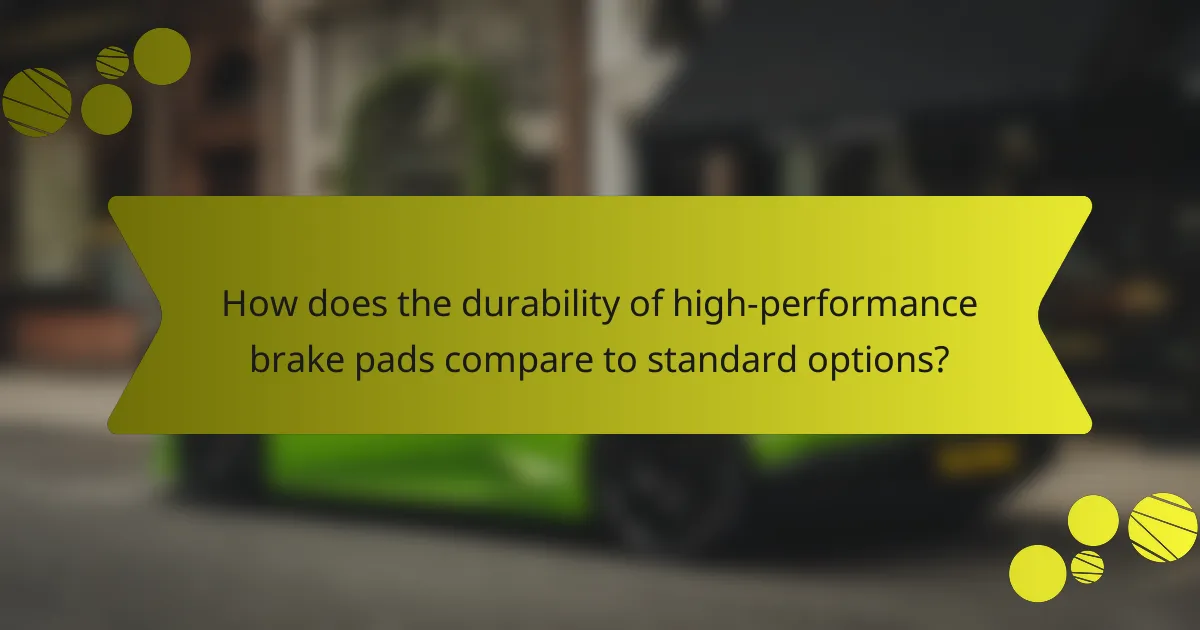
How does the durability of high-performance brake pads compare to standard options?
High-performance brake pads generally offer superior durability compared to standard options. They are designed with advanced materials that withstand higher temperatures and resist wear. For example, high-performance pads can last up to 50% longer than standard pads under similar driving conditions. Their unique formulation enhances braking efficiency, making them ideal for demanding driving styles.
What factors influence the lifespan of high-performance brake pads?
High-performance brake pads typically last between 20,000 to 70,000 miles, influenced by factors like driving style, material composition, and vehicle type. Aggressive driving and frequent braking can significantly reduce lifespan. Additionally, the quality of the brake pad material plays a crucial role; ceramic pads often last longer than semi-metallic ones. Compatibility with specific vehicle models also impacts performance and durability, as some designs may wear out faster due to misalignment or inadequate heat dissipation.
How do environmental conditions affect brake pad durability?
Environmental conditions significantly impact brake pad durability. Factors such as temperature, humidity, and road conditions can accelerate wear. High-performance brake pads are designed to withstand extreme conditions, enhancing longevity. For example, pads made from advanced materials resist fading in high temperatures, ensuring consistent braking performance. Additionally, areas with frequent rain or snow may require pads that offer better grip to maintain safety.

Which popular vehicle models are compatible with high-performance brake pads?
Many popular vehicle models are compatible with high-performance brake pads, enhancing braking efficiency. Models such as the Ford Mustang, Chevrolet Camaro, BMW 3 Series, Audi A4, and Subaru WRX are known for their compatibility. High-performance brake pads provide improved stopping power and heat resistance, making them ideal for performance-oriented vehicles.
What specific brake pad options are available for sports cars?
High-performance brake pads for sports cars include options like ceramic, carbon-ceramic, and organic formulations. These pads offer superior stopping power, heat resistance, and compatibility with popular models like the Porsche 911 and Ford Mustang.
Ceramic brake pads provide excellent performance and low dust production, making them ideal for daily driving and occasional track use. Carbon-ceramic pads excel in high-temperature environments, ensuring durability and consistent performance during aggressive driving. Organic pads are often quieter and provide a smooth feel but may wear faster under extreme conditions.
When selecting brake pads, consider factors such as intended use, vehicle model, and desired performance characteristics. Brands like Brembo, EBC, and Hawk Racing offer specialized options tailored to various sports car needs.
How can high-performance brake pads be matched to luxury vehicles?
High-performance brake pads can enhance luxury vehicles by providing superior stopping power and durability. To match them effectively, consider the vehicle’s weight, driving style, and specific model requirements.
1. Assess vehicle specifications: Determine weight and performance capabilities.
2. Evaluate driving conditions: Identify typical driving scenarios, such as city or highway.
3. Choose material composition: Options include ceramic, semi-metallic, or organic pads based on performance needs.
4. Check compatibility: Ensure pads are designed for the specific luxury model to maintain safety and performance.
Selecting the right high-performance brake pads can significantly improve braking efficiency and overall driving experience.
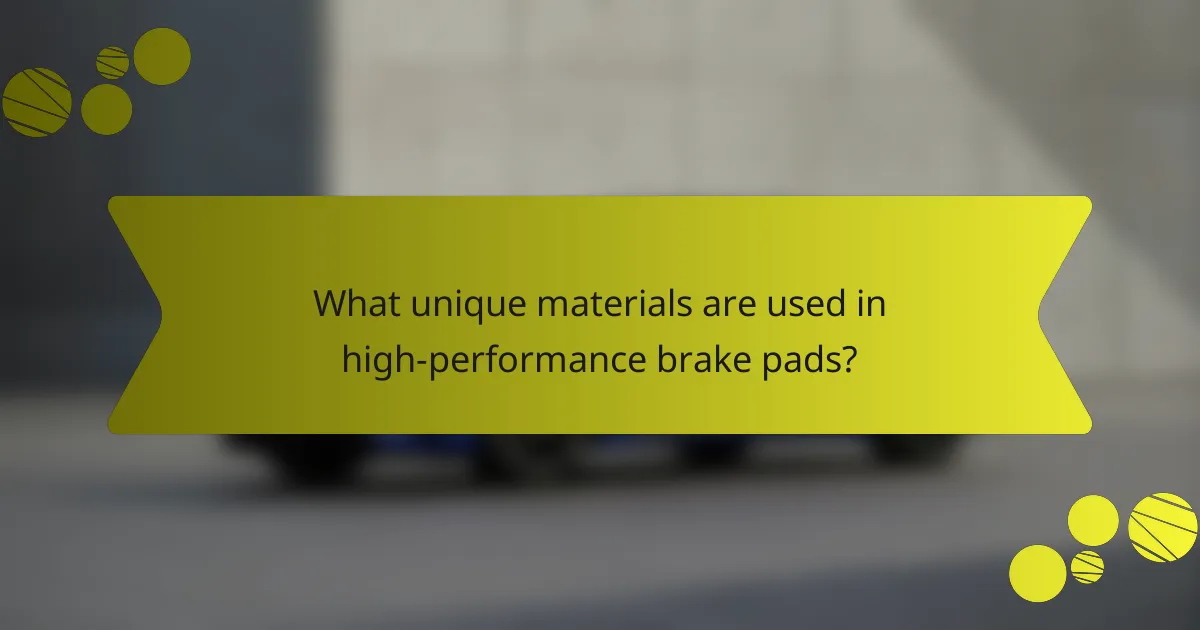
What unique materials are used in high-performance brake pads?
High-performance brake pads often utilize unique materials such as carbon composites, ceramic compounds, and aramid fibers. These materials enhance braking efficiency, reduce fade under high temperatures, and improve durability. Carbon composites provide lightweight strength, while ceramic compounds offer low dust production and quieter operation. Aramid fibers contribute to thermal stability, ensuring consistent performance in demanding conditions.
How do ceramic and metallic compounds differ in brake pad performance?
Ceramic and metallic compounds differ significantly in brake pad performance. Ceramic pads offer quieter operation and less dust, while metallic pads provide superior heat dissipation and durability.
Ceramic brake pads, made from a mixture of ceramic fibers, non-ferrous materials, and bonding agents, excel in low noise and low dust production. They maintain consistent performance in moderate driving conditions, making them suitable for everyday vehicles.
Metallic brake pads, composed of metal fibers and other materials, deliver exceptional stopping power and heat resistance. They perform well under extreme conditions, making them ideal for high-performance and heavy-duty applications.
In summary, choose ceramic pads for daily driving comfort and metallic pads for high-performance demands.
What innovations are emerging in brake pad technology?
Emerging innovations in brake pad technology include advanced materials, enhanced performance features, and improved eco-friendliness. These developments focus on increasing durability, reducing noise, and optimizing compatibility with popular vehicle models. For instance, carbon-ceramic composites offer superior heat resistance and longevity, while formulations with lower metal content reduce environmental impact. Additionally, smart brake pads equipped with sensors provide real-time performance data, enhancing safety and maintenance awareness.

How do high-performance brake pads impact driving experience?
High-performance brake pads significantly enhance the driving experience by improving stopping power and responsiveness. These pads offer superior heat dissipation, reducing brake fade during intense driving conditions. Their durability extends lifespan, often outlasting standard pads, which means less frequent replacements. Compatibility with popular vehicle models ensures drivers can upgrade their braking system without extensive modifications.
What changes in stopping power can drivers expect?
Drivers can expect improved stopping power with high-performance brake pads. These pads offer enhanced friction materials, resulting in shorter stopping distances and better heat dissipation. Compatibility with popular models ensures drivers benefit from optimized braking performance tailored to their vehicle. Additionally, durability increases, reducing the frequency of replacements and maintenance costs.
How do high-performance brake pads affect noise levels during operation?
High-performance brake pads typically reduce noise levels during operation due to their advanced materials and design. These pads often incorporate noise-dampening technology, which minimizes vibrations and sound. As a result, users experience quieter braking performance compared to standard pads. Additionally, the high friction coefficient of these pads contributes to smoother stops, further decreasing noise generation.
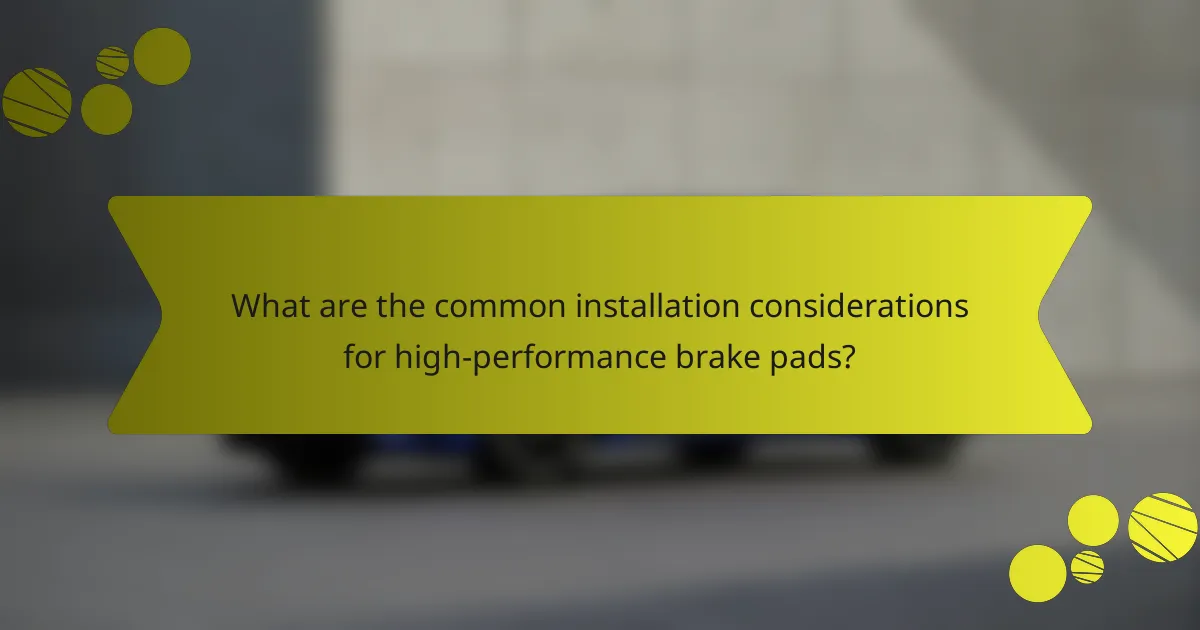
What are the common installation considerations for high-performance brake pads?
High-performance brake pads require careful installation considerations to ensure optimal performance. First, ensure compatibility with your vehicle’s make and model. Check the pad material, as options like ceramic or semi-metallic have different properties. Proper bedding is essential for effective braking; follow manufacturer guidelines for this process. Additionally, inspect existing rotors for wear, as uneven surfaces can affect pad performance. Finally, consider the installation environment; a clean, dry area promotes better adhesion and reduces contamination risks.
How can users ensure proper fitment and functionality?
Users can ensure proper fitment and functionality by selecting brake pads specifically designed for their vehicle model. Verify compatibility through manufacturer specifications or trusted automotive resources. Additionally, consider factors such as pad thickness, material composition, and performance ratings to enhance braking efficiency. Regularly inspect brake components for wear and ensure installation is performed by a qualified technician to maintain optimal performance.
What tools are necessary for installing high-performance brake pads?
To install high-performance brake pads, you need a socket set, torque wrench, jack stands, brake cleaner, and a C-clamp. These tools ensure proper installation and maintenance of brake systems. A torque wrench is essential for achieving the correct fastening torque, enhancing safety and performance.

What are the best practices for maintaining high-performance brake pads?
To maintain high-performance brake pads, regularly inspect and clean them, ensure proper installation, and monitor for wear. Additionally, use compatible brake fluid and avoid excessive heat.
1. Inspect brake pads every 5,000 miles for wear.
2. Clean pads and rotors to remove dust and debris.
3. Ensure correct installation to prevent uneven wear.
4. Use high-quality brake fluid to maintain performance.
5. Avoid aggressive driving to reduce heat buildup.
How often should high-performance brake pads be inspected?
High-performance brake pads should be inspected every 6,000 to 10,000 miles or as recommended by the vehicle manufacturer. Regular inspections ensure optimal performance and safety. Factors like driving style and conditions may influence inspection frequency. Inspect pads for wear, cracks, and heat damage to maintain braking efficiency.
What common mistakes should be avoided during maintenance?
To avoid common mistakes during maintenance of high-performance brake pads, ensure proper installation and regular inspections. Neglecting compatibility with specific vehicle models can lead to poor performance. Additionally, overlooking the manufacturer’s guidelines on break-in periods and maintenance schedules may reduce durability. Lastly, using incorrect cleaning products can damage the pads.
